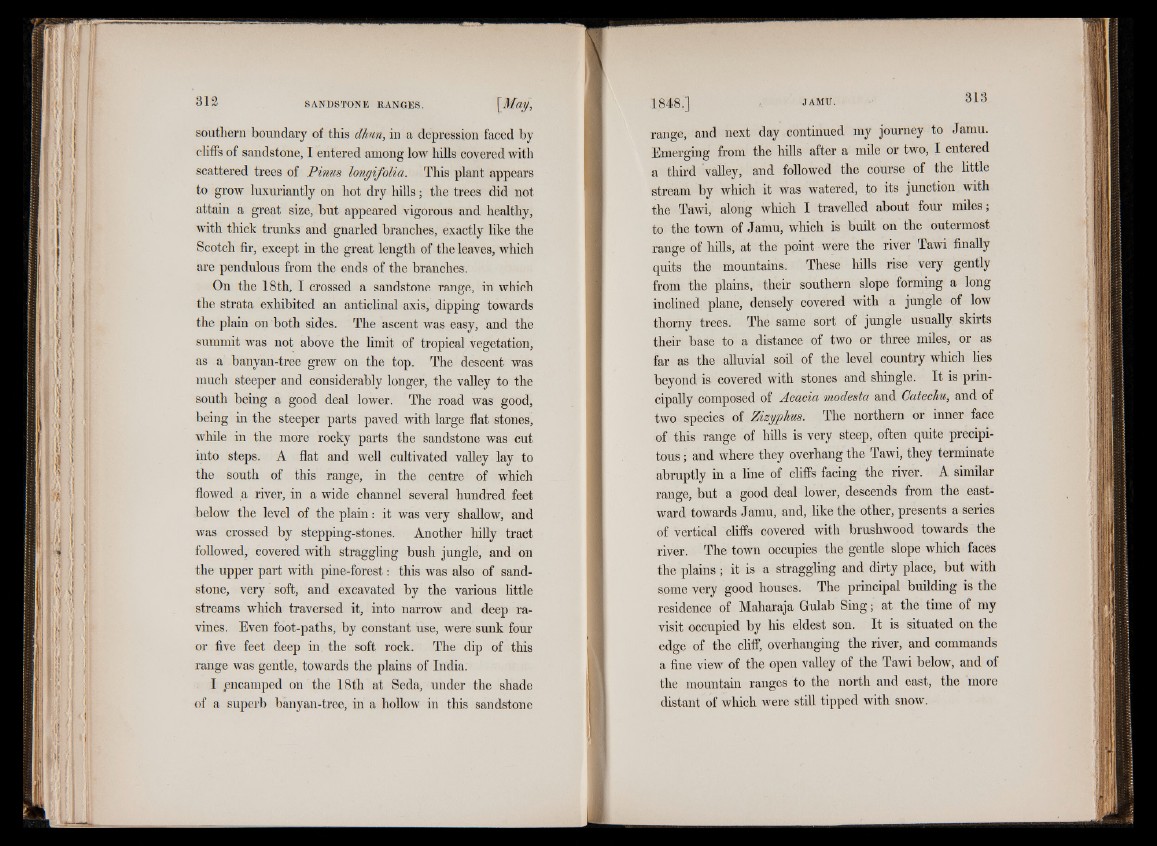
southern boundary of this dhun, in a depression faced by
cliffs of sandstone, I entered among low hills covered with
scattered trees of Pim s longifolia. This plant appears
to grow luxuriantly on hot dry hills; the trees did not
attain a great size, but appeared vigorous and healthy,
with thick trunks and gnarled branches, exactly like the
Scotch fir, except in the great length of the leaves, which
are pendulous from the ends of the branches.
On the 18th, I crossed a sandstone range, in which
the strata exhibited an anticlinal axis, dipping towards
the plain on both sides. The ascent was easy, and the
summit was not above the limit of tropical vegetation,
as a banyan-tree grew on the top. The descent was
much steeper and considerably longer, the valley to the
south being a good deal lower. The road was good,
being in the steeper parts paved with large flat stones,
while in the more rocky parts the sandstone was cut
into steps. A flat and well cultivated valley lay to
the south of this range, in the centre of which
flowed a river, in a wide channel several hundred feet
below the level of the plain: it was very shallow, and
was crossed by stepping-stones. Another hilly tract
followed, covered with straggling bush jungle, and on
the upper part with pine-forest: this was also of sandstone,
very soft, and excavated by the various little
streams which traversed it, into narrow and deep ravines.
Even foot-paths, by constant use, were sunk four
or five feet deep in the soft rock. The dip of this
range was gentle, towards the plains of India.
I .encamped on the 18th at Seda, under the shade
of a superb banyan-tree, in a hollow in this sandstone
range, and next day continued my journey to Jamu.
Emerging from the hills after a mile or two, I entered
a third valley, and followed the course of the little
stream by which it was watered, to its junction with
the Tawi, along which I travelled about four miles;
to the town of Jamu, which is built on the outermost
range of hills, at the point were the river Tawi finally
quits the mountains. These hills rise very gently
from the plains, their southern slope forming a long
inclined plane, densely covered with a jungle of low
thorny trees. The same sort of jungle usually skirts
their base to a distance of two or three miles, or as
far as the alluvial soil of the level country which lies
beyond is covered with stones and shingle. It is principally
composed of Acacia modesta and Catechu, and of
two species of Zizgphus. The northern or inner face
of this range of hills is very steep, often quite precipitous
; and where they overhang the Tawi, they terminate
abruptly in a line of cliffs facing the river. A similar
range, but a good deal lower, descends from the eastward
towards Jamu, and, like the other, presents a series
of vertical cliffs covered with brushwood towards the
river. The town occupies the gentle slope which faces
the plains ; it is a straggling and dirty place, but with
some very good houses. The principal building is the
residence of Maharaja Gulab Sing; at the time of my
visit occupied by his eldest son. It is situated on the
edge of the cliff, overhanging the river, and commands
a fine view of the open valley of the Tawi below, and of
the mountain ranges to the north and east, the more
distant of which were still tipped with snow.